
 Work and worklessness
Work and worklessness
Headlines
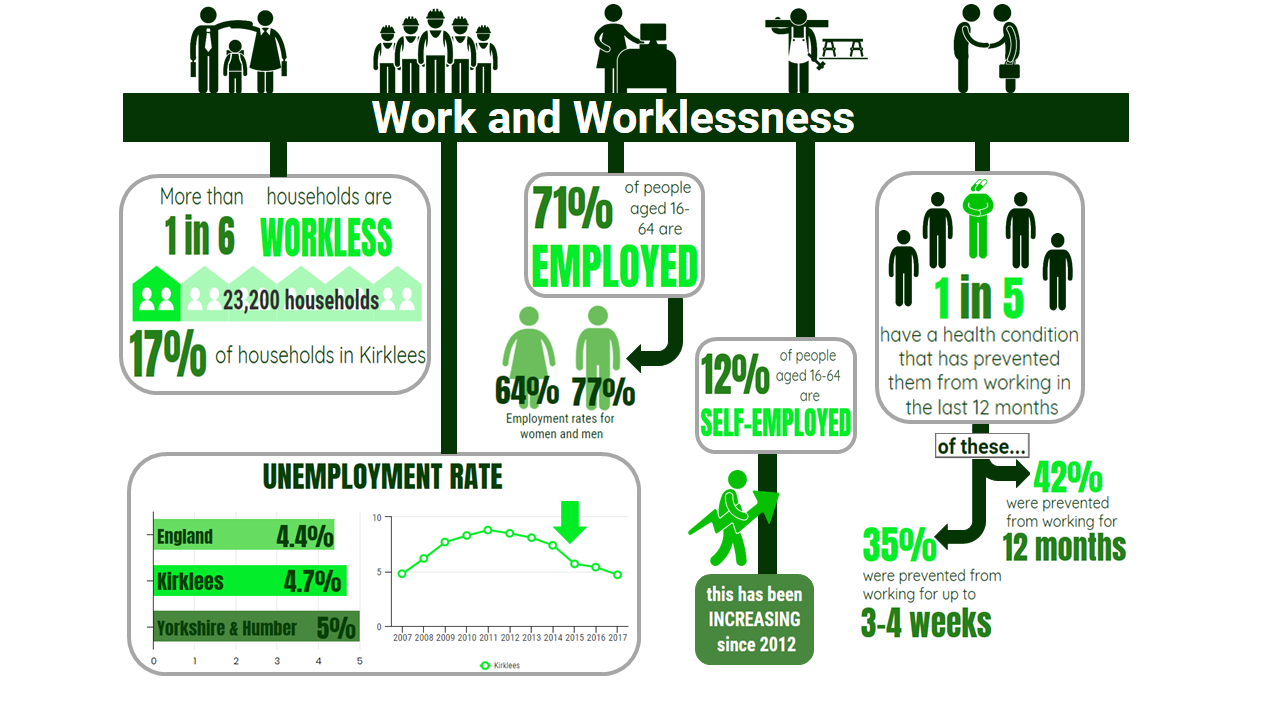
Why is this issue important?
Work is a primary determinant of health and wellbeing. Employment has benefits for individuals, families and society as a whole and healthy, skilled, productive people make a healthy economy.
Conversely worklessness has both short and long-term effects on physical and mental health, and along with income, is one of the two main drivers of socio-economic deprivation (1).
The definition of worklessness is wider than unemployment. In Kirklees, the Worklessness definition includes the working age population who are unemployed and economically inactive. Examples of people who may be workless include:
- People claiming a benefit such as Universal Credit
- People claiming benefits such as Incapacity Benefit, the Employment and Support Allowance and Income Support
- People with caring responsibilities
- People with a health condition or disability
People who voluntarily take themselves out of the labour market (e.g. full time students and people who have taken early retirement) are not normally included in the definition of worklessness.
Unemployment
The unemployed population are defined as “people without a job who were available to start work in the two weeks following their interview and who had either looked for work in the four weeks prior to interview or were waiting to start a job they had already obtained.”
Unemployment is associated with an increased risk of mortality and morbidity, including limiting illness, cardiovascular disease, poor mental health, suicide and health-damaging behaviours (2).
In Kirklees, 4.7% of the population aged 16 to 64 years were unemployed in 2017. The unemployment rate in Kirklees – that is the proportion of the economically active population who are unemployed – is lower Yorkshire and Humber (5.0%) but higher than England (4.4%). The unemployment rate has been steadily decreasing over the last 6 years (down from 8.8% in 2011) (3)
The number of people who are classed as long-term unemployed (12 months or more) has decreased in Kirklees. It is estimated that 1225 people were unemployed for 12 months or more in 2016 compared to 1575 people in 2015 (4).
Job density in Kirklees is significantly lower than the regional and national average. Job density is the number of filled jobs in an area divided by the resident population aged 16-64 in that area (e.g. a job density of 1 would mean there is 1 job per person aged 16-64. In Kirklees the job density is 0.67, compared to 0.8 in Yorkshire and the Humber and 0.85 across England.
Workless households
Workless households are defined as “Households where no-one aged 16 or over is in employment. These members may be unemployed or economically inactive. Economically inactive members may be unavailable to work because of family commitments, retirement or study, or unable to work through sickness or disability.”
There are 23,200 workless households in Kirklees – this equates to 16.6% of households in the district (Jan-Dec 2017). By comparison 15.8% of households in Yorkshire and Humber are workless and 14.5% in Great Britain. The number and proportion of workless households in Kirklees has increased over the last two years (from 20,900 or 15% in 2015) (5).
In Yorkshire and Humber, 13.7% of children live in households that are workless, this compares to 10.7% for Great Britain as a whole. Families without a working member are likely to experience persistent low income and poverty. The proportion of children that live in workless households in Yorkshire and Humber has decreased in recent years (6).
Community assets and action
What would an asset-based approach to work and worklessness look like?
An asset-based approach starts with ‘what’s strong’ rather than what’s wrong. Please see the assets section for more information about our approach to understanding assets in the KJSA.
An asset-based approach to work and worklessness would incorporate both a strength-based and ‘restorative practice’ approach to working with individuals (‘working with’ not ‘doing to’, identifying existing assets available to the individual, etc) and an asset-based approach to design, delivery and commissioning. This means services are co-produced in response to local needs and build on what is already working well in a local area or with a particular community. An asset-based approach also views older people and the ageing population as assets rather than as a ‘burden’. Older people make up an increasing proportion of the workforce and have valuable experiences and insights to contribute. Working later in life has benefits for individuals, families, employers and wider society.
What are the assets around this issue?
Health assets are those things that enhance the ability of individuals, communities and populations to maintain and sustain health and well-being. These include things like skills, capacity, knowledge, networks and connections, the effectiveness of groups and organisations and local physical and economic resources. Assets are hugely important to how we feel about ourselves, the strength of our social and community connections and how these shape our health and wellbeing.
There are a range of assets in Kirklees, delivered by the council and in partnership with the third sector. These include:
The Works Better project in the Leeds City region covers Kirklees, Calderdale and Wakefield Local Authority Areas. The programme supports people who want to overcome barriers that are currently preventing them from entering the workforce by helping them become ‘work ready’. Works Better supports people of all ages, irrespective of their background and personal circumstances. The programme recognises that barriers to work will mean something different for everybody and could include childcare issues, low confidence or a lack of basic IT skills. In order to overcome these barriers, the Works Better team puts together uniquely tailored support package to maximise the individual’s potential and help them enter, or return to work.
Job Connector’s (part of the Works Better project) support employers to open up good quality, sustainable jobs that are accessible for local unemployed residents to apply for. One of the primary functions of the role is to review current recruitment practices ensuring they are inclusive and identifying issues/barriers which would prevent candidates being able to apply whilst offering solutions to combat these barriers. Job Connector’s gather on the ground intelligence of what local employer expectations are, which in turn influences provision and support being delivered to unemployed residents across the district through the multiple out of work programmes.
REAL Employment are a small team who work with adults with learning disabilities to support them into work. This year they have secured jobs for over 50 customers and this has been achieved by working in partnership with various agencies including the disability Employment Advisors from local Job Centres, local training providers, local schools and colleges, local and national employers and other council functions including Human Resources. This is a key part of the early intervention agenda.
Step by Step (SBS) provides walk in support to Kirklees residents, regardless of their age, employment status or whether they are claiming benefits or not. The service is also open to residents already in work who may need support in searching for an alternative job. Employment support is provided in both one-to-one sessions or in small groups. The help provided is personalised to your specific requirements and delivered through high quality information, advice and guidance to help overcome any barriers you may have into employment.
There are also a range of adult learning courses delivered across Kirklees. These are aimed at people aged 19+ who do not have a full Level 2 qualification, live in areas of disadvantage, have learning difficulties or disabilities or have significant barriers to learning. Courses include Healthy Cooking, Fit4Life, Confidence and Wellbeing, Reading Friends, Helping in Schools and Basic IT.
Community Learning Works is a partnership project between the Council, the third sector and other mainstream learning providers which supports people who face the most significant challenges and are furthest away from the job market to progress towards and into employment.
The employment and skills pages on the Kirklees Council website provides a useful starting point for information and resources.
Fit for Work is a national resource providing occupational health advice which can be beneficial in supporting individuals to manage their health condition at home and at work, and can support a faster return to work from sickness absence.
Self care resources are available for people in Kirklees living with long term conditions whether they are in work, wanting to return to work or no longer working.
The DPH Annual Report 2017/18 on Ageing Well includes a number of local assets including several which support older people into training, learning or employment.
What significant factors are affecting this issue?
Health and disability
Poor health and disability is both a cause and consequence of unemployment. One of the key reasons why productivity is lower in the north of England is that health is also worse in the north. Spells of ill health increase the risk of job loss and lead to lower wages when people return to work (7).
Around 1 in 3 working-age people in the UK have a long-term health condition which if not managed, could put their participation in work at risk. By 2040, this is predicted to rise to 40%. Around 42% of employees with a health condition felt it affected their work but 1 in 3 have not discussed it with their employer (8).
Learning and skills
Learning and skills levels influence a person’s employability and work roles are strongly linked to learning and skills across the life course. For more information see the Learning and skills section of the KJSA.
Sickness Absence
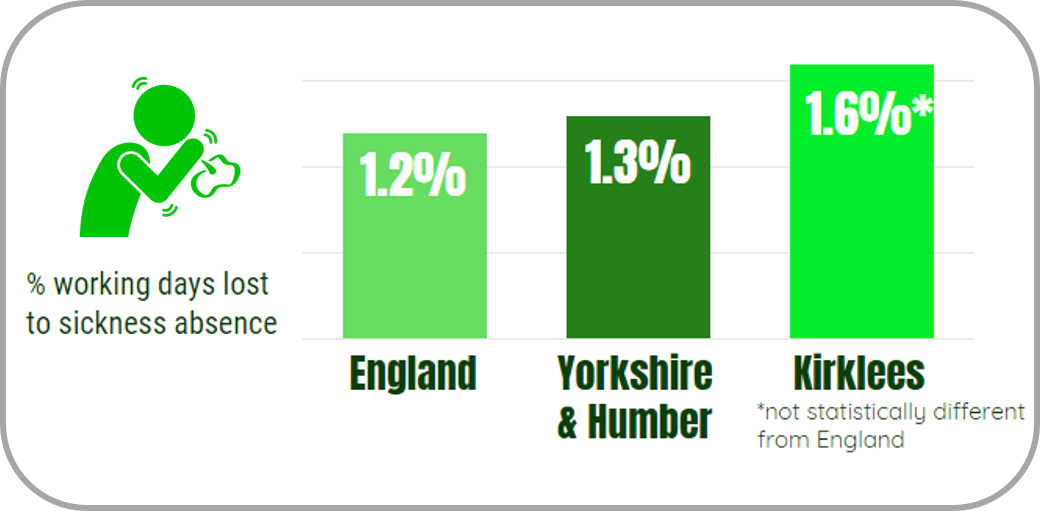
Sickness absence is an indicator of the health of the working population and results in lost productivity for businesses. Whilst the number of working days lost to sickness has decreased significantly over the past decade or so, around 137 million working days were lost to sickness absence or injury in the UK in 2016 (9). It is estimated this costs the economy at least £15 billion annually (10). The majority of sickness absence is genuine but much of it is preventable.
The longer someone is off work as a result of ill health, the less likely they are to return to work; research suggests that someone who has been off sick for 6 months or longer has an 80% chance of being off work for 5 years (11). Returning to work can be good for health and wellbeing, reversing the effects of long-term unemployment and prolonged sickness absence (12). Employers have significant scope to facilitate an employee’s early return from sickness absence through effective attendance management.
Recovery from the recession
Following the last recession (between 2008 and early 2009), the employment rate in Kirklees fell from 73.2% in 2007/08 to a low of 66.7% in 2011/12 (people aged 16-64 years). Since then, the employment rate has been increasing but remains lower than pre-recession figures.
Similarly unemployment among those aged 16 to 64 years is at its lowest in Kirklees since 2011/12 when it was 9.4% but remains higher than pre-recession figures (4.8% in 2007/08) (13).
Real wage growth
There is a growing understanding that wages, rather than employment rates, are likely to have taken the strain of the impact of the labour market shock that occurred following the last recession.
Whilst employment levels and wages have both increased in recent years, the rate of real wage growth has not. Real wage growth is what wages are worth in terms of the goods and services that can be bought – this is important as real wages are a key factor in determining living standards and disposable income which impacts on health and wellbeing.
In April 2017, the Office for National Statistics reported that wage growth fell below inflation for the first time since 2014. Inflation rose to 2.6% year-on-year, while three month average wage growth was 2.1% over the same period of time. By comparison, at the same time in 2016, wage growth was 2.2% but inflation was only 0.7%. This increase in inflation was in part attributed to the fall in the value of sterling after the EU referendum but the fall in wage growth is seen to be unusual at a time when employment nationally is at a record high – a high employment rate is normally an indicator of a strong economy, and wage growth is usually expected (14).
Automation
Automation, or the use of machines and automatic equipment is becoming an increasing method of creating products within industry and business.
It is anticipated that Automation will produce significant productivity gains, reshaping specific sectors and occupations. It is not expected that Automation will lead to a reduction in jobs overall, however it is more likely to lead to a reallocation of roles and a significant change in duties and therefore skills required.
Jobs with the highest potential for automation typically have lower wages. It is estimated that low wage jobs have five times the technical potential to be automated of high paid jobs. However, the demand for work in creative, planning, decision-making, managerial and caring roles will increase. New jobs and ways of working, aligned to automation will emerge (15).
Non-standard working schedules
Non-standard working schedules can take many forms and can include temporary working, part time work, shifts, zero hours contracts and the ‘gig’ economy. These can have an impact on health, employment duration, stability of work, earning power, career prospects, training and development opportunities and exposure to poverty. Non-standard working schedules differ across sex, age group and level of education and incorporate a broad range of economically active people (16).
Since 2012, there has been an increase in the numbers of people in employment in the UK on contracts where they are not guaranteed any hours of work in a given week; these are also known as “zero-hours contracts”.
In 2012, 252,000 people in the UK (quarter 4- October to December) reported they were on a ‘zero hours contract’ rising to 905,000 people at the end of the same quarter in 2016; over a 350% increase.
Data on the numbers of people on zero-hour contracts is not available for Kirklees. In Yorkshire and Humber in October to December 2016, 80,000 people were in employment in a zero-hours contract or 3.1% of people in employment in the region – this is an increase from 2.7% of people in employment in Yorkshire and Humber over the same period in 2015 (17).
Non-standard work patterns can have both positive and negative effects on health and wellbeing, depending on the perspective of the individual. Overwhelmingly the evidence suggests employees on shift or non-standard work schedules are significantly more likely to have lower levels of good self-reported health and wellbeing, compared to those on non-flexible schedules (18).
In work poverty
Nationally, in-work poverty is higher than at any time in the last 20 years. Nationally, four million workers live in poverty, a rise of over half a million over five years. In-work poverty has risen faster than employment, driven overwhelmingly by increasing poverty amongst working parents (19). A working parent is over one-and-a-half times more likely to be in poverty than a working non-parent.
Whilst poverty is associated with unemployment, it has become harder to live a comfortable life on a low or even middle income. Of those people who are working in Kirklees, 29% report a household income of £20,000 or less (including benefits and allowances) and 1 in 5 (19%) of those who are working report that they worry about money all of the time or almost all of the time (20).
See also the Household income section of the Poverty section of the KJSA for more information.
The ageing workforce
By 2022 it is estimated that 1 in 3 workers will be over 50 years of age. As the workforce ages, early exit from the labour market is an increasing problem and is not keeping pace with increases in life expectancy and the Department for Work & Pensions report that the current rate of loss of over 50s from the labour force is expected to lead to a ‘brain drain’ of skilled staff. A number of factors contribute to this problem including health issues, caring responsibilities and redundancy combined with a lack of suitable skills for re-employment (21).
Working later in life has benefits for individuals and families, employers and wider society. For most people, remaining in work as they age is good for both finances and health and wellbeing.
What does local data tell us?
| Kirklees | Yorkshire & Humber | England | |
| Employment | 71.1% | 72.8% | 74.4% |
| Unemployment aged 16-64 | 4.7% | 5% | 4.4% |
| Workless households | 17% | 16.8% | 15.1% |
| Working days lost to sickness absence | 1.6% | 1.3% | 1.2% |
Health and disability
In Kirklees, 71% of working age people report that they have a long-term condition and nearly two thirds have at least one lifestyle risk factor which puts them at increased risk of developing one:
- 64% are not achieving the recommend amount of physical activity
- 1 in 3 are unlikely to eat 5 or more portions of fruit and veg a day
- 18% are current smokers
- 23% are exceeding recommended safe drinking limits (15 units or more) (22)
Sickness absence
In Kirklees, 1.6% of working days are lost annually as a result of sickness absence. This compares to 1.3% of working days in Yorkshire and Humber and an England average of 1.2% (23)
Most sickness absence is short-term with minor illness such as coughs and colds being the most common reason for absence. However, data from the Current Living in Kirklees (CLiK) survey shows that almost 1 in 5 people in Kirklees report that they have a physical or mental health condition that has prevented them from working in the last 12 months. Of these people, 35% report that this has prevented them from working for a maximum of 3-4 weeks and 42% report that this has prevented them from working for 12 months (24).
In work poverty
Of those people who are working and living in Kirklees, the CLiK survey results show that 29% report a household income of £20,000 or less (including benefits and allowances) and 1 in 5 (19%) of those who are working report that they worry about money all of the time or almost all of the time.
See also the Household income section of the Poverty section of the KJSA for more information.
The ageing workforce
Employment status changes over the course of later life as people make different transitions from working to retirement (25).
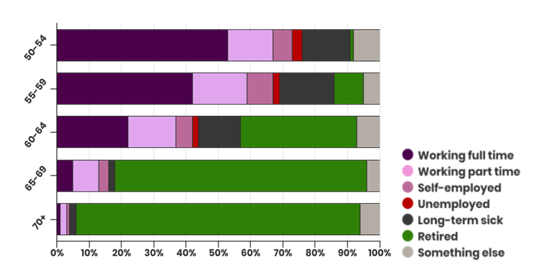
Employment in later life is positively associated with having a sense of purpose and reduced feelings of social isolation. For more information on work and employment in later life in Kirklees, please see the DPH Annual Report 2017/18 on Ageing Well in Kirklees.
16% of workers in Kirklees report that they currently look after or give support to a family member, friend, neighbour or others because of long-term physical or mental ill-health, disability or problems related to old age. Having caring responsibilities becomes more common as people age and most carers in Kirklees are over 45 years of age. The average age of the person(s) they are caring for is 67.2 years (26).
Which groups are affected most by this issue?
People with long-term health problems or disabilities
Poor health and disability is both a cause and consequence of unemployment. It is estimated that 16% of working age adults in the U.K. are have some form of disability; in Kirklees this equates to around 43,500 disabled people of working age. 3.37% of the Kirklees population are in receipt of Disability Living Allowance (DWP, Q3 2017). The prevalence of disability among working age people has risen in recent years and is likely to continue to do so (27).
The impact of disability on a person’s likelihood of finding and keeping a job is considerable. Employment rates for people with a disability are significantly lower than those of people with no limiting health problems. Nationally, 80% of people who are non-disabled are employed compared to 48% of people who are disabled – a 32 percentage point gap (28).
According to CLiK survey 2016, 35% of people in Kirklees who have a disability reported that they were working compared to 70% of people who reported that they do not have a disability.
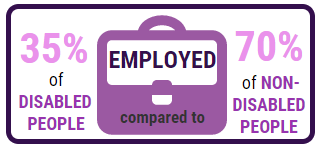
In Kirklees, the gap in the employment rate between people with a learning disability, and the gap in the employment rate between people in contact with secondary care mental health services and the overall employment rate are particularly marked at 59.5 percentage points and 65.1 percentage points respectively (29).
Supporting people with long term conditions to remain in work is generally more cost effective for employers than losing the knowledge, experience and the direct and indirect costs of recruitment and replacement (30). Helping people with health issues to obtain or retain work, and be happy and productive within the workplace is a crucial part of the economic success and wellbeing of every community (31).
There is also a strong economic argument to address health-related worklessness. It is estimated that when a claimant (disabled or non-disabled) moves into a job paying the National Living Wage, there are savings of £6,900 for government, a £13,100 boost to the local economy, and a £6,500 gain to the individual (32).
People claiming health-related benefits
Just over 33,000 working age people in Kirklees are claiming benefits of which around 25,000 are claiming one of the main out of work benefits. Of these, 54% are claiming health-related welfare benefits as illness and disability can be a barrier to obtaining work (33).
Of those people claiming Employment Support Allowance (ESA) or Incapacity Benefit, 13% have been on the benefit for more than five years. In terms of health conditions nearly 1 in 2 (48%) claimants of ESA are categorised as claiming due to mental and behavioural disorders and 13% are claiming due to diseases of the musculoskeletal system and connective tissue (34).
People taking sickness absence from work
National data shows that in 2016, the groups who experienced the highest rates of sickness absence were women, older workers, people with long-term health conditions, smokers, public health sector workers and those working in the largest organisations (those with 500 or more employees) (35). Kirklees level data is not available.
However we do know from the CLiK survey that around 1 in 3 working adults aged 50+ years and 1 in 4 aged under 50 years have been prevented from working in the past 12 months due to a physical or mental health condition. 59% of absentees aged 50+ years were off work for more than 6 months.
Lone parents
Nearly half of children in lone-parent families live in poverty (49%) compared with 1in 4 of those in couple families (25%) (36). Just over half of working lone parents are low paid compared with only 37% of second earners in couples and 21% of main earners in couples. Lone parents are more concentrated in many sectors with high levels of low pay, and they are more likely to below paid in those industries than either mothers or fathers in couples (37).
Young people
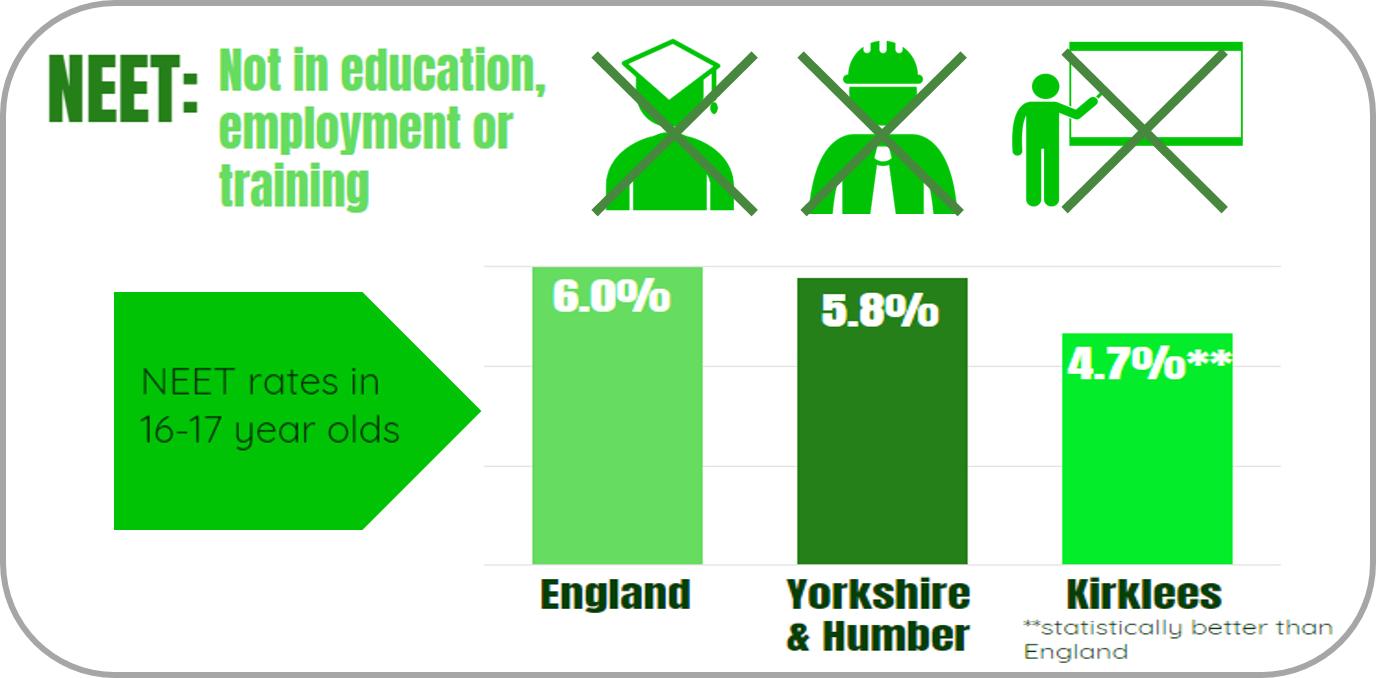
Local authorities have specific responsibilities in relation to young people who are not in employment, education or training (NEET). The NEET rate in Kirklees is significantly better than England and Yorkshire and the Humber.
Unemployment rates are higher among young people but have generally been falling since 2013. Nationally, the unemployment rate for 16-24 year olds in November 2017 to January 2018 was 12.3%, unchanged from a year ago, and 14% of unemployed 16-24 year olds had been unemployed for over 12 months. Excluding young people in full-time education, the unemployment rate for 16-24 year olds not in full-time education over the same period was 10.7%, compared to 10.8% a year ago (38).
The picture is very similar in Kirklees, where unemployment rates are significantly higher for 16-24 year olds than other age groups, although this has been gradually falling. In October 2016 – September 2017 the unemployment rate for 16-24 year olds was 14.8%, down from 21.9% in the same period for 2012-13 and from 17.3% in 2015-16.
Children
Worklessness does not just impact on workless individuals. Children are more likely to be in relative poverty if they are in a workless family. In the UK in 1996/7, 83% of children in workless families lived in poverty. By 2012/13, the risk of poverty for those children had reduced to 63%; still high but a considerable improvement. However, since then the risk has grown again, with 73% of children in workless families now living in poverty (39).
Importantly, virtually all the recent rise in child poverty has taken place within working families of all types whether they are lone-parent or couple families and regardless of the number of adults in work and whether they are full or part-time workers (40).
Where is this causing greatest concern?
Inequalities
Poor health is both a cause and consequence of unemployment. There are inequalities in life expectancy and healthy life expectancy across Kirklees. More deprived areas have poorer health outcomes and have higher unemployment levels, for example 20% of people in Dewsbury West are workless compared to 3% in Holme Valley South (41).
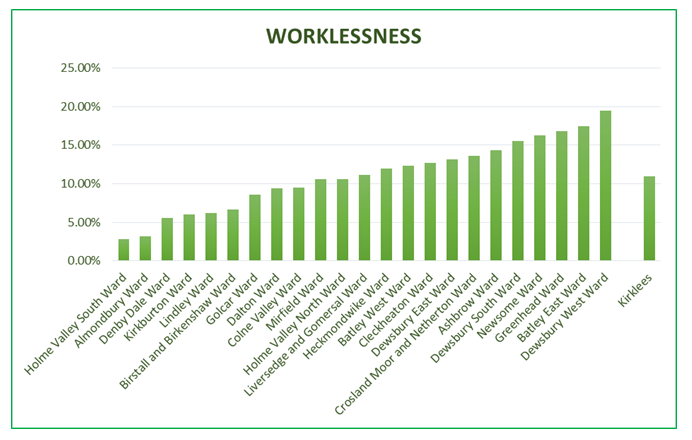
For information on inequalities in health in Kirklees see the Inequalities overview section of the KJSA.
Health-related out of work benefits by ward
The proportion of working age people who are claiming benefits due to illness or disability in Kirklees is higher in more deprived areas of Kirklees. In the instance of Incapacity Benefit, the latest available ward level data (Q4, 2016), shows that the ward with the highest proportion of claimants is Dewsbury West (9.75%), followed by Ashbrow (9.23%), Crosland Moor and Netherton (8.50%), and Dewsbury East (8.42%). By comparison, the lowest proportion of claimants can be found in Kirkburton (3.16%), Holme Valley South (3.54%), Denby Dale (3.84%), and Holme Valley North (4.40%) (42).
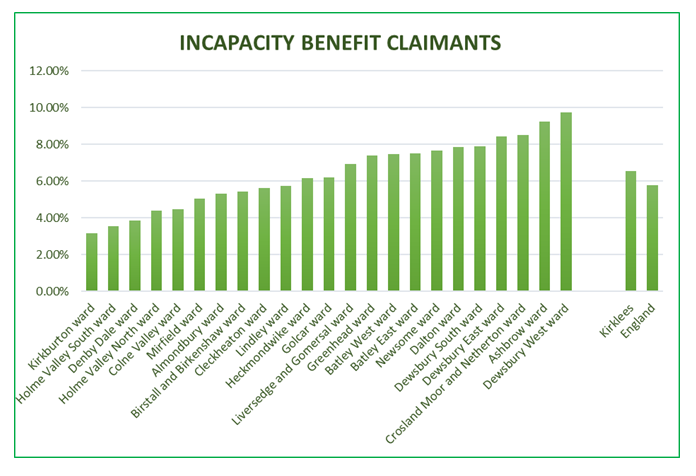
Views of local people
There are a range of adult learning courses delivered across Kirklees. These are aimed at people aged 19+ who do not have a full Level 2 qualification, live in areas of disadvantage, have learning difficulties or disabilities or have significant barriers to learning. Courses include Healthy Cooking, Fit4Life, Confidence and Wellbeing, Reading Friends, Helping in Schools and Basic IT. Post course feedback has shown the following:
- The majority of learners felt ready to take the next steps for their personal development;
- The majority of learners felt that the course they had taken had increased their personal skills and confidence for employment purposes.
An analysis of the feedback from the Works Better programme has shown that the barriers local people face in accessing work include personal confidence, work experience, health issues and outdated skills.
Once someone has an interview or job offer, other barriers exist, including:
- Identification – e.g provisional driving license or birth certificate
- Clothing – appropriate work clothes
- The need to disclose a criminal record via the DBS Certificate
- Money or bus passes for travel to and from work or interview
What could commissioners and service planners consider?
- Start with ‘what’s strong rather than what’s wrong’ by understanding and building on the existing and emerging local community assets and examples of ‘people helping people’ described above
- Consider the impact on Protected Characteristic Groups and give due regard to the elements of the Public Sector Equality Duty to eliminate discrimination, advance equality of opportunity and foster good relations between different people. Refer to the inequalities overview for more information
- Read the recommendations from the Learning and Skills section [HYPERLINK WHEN WEB PAGES CHANGED]
- Ensure that business facing offers include the following
- Promotion of the benefits of better health at work to businesses including increased productivity and reduced sickness absence
- Promotion of ‘health at work’ standards and interventions such as the Health and Safety Executive Management Standards and Employer Time to Change Pledge.
- Embedded ‘health at work’ messaging to work with local businesses which offers suitable advice and guidance for Small and Medium Enterprises.
- Influencing of local business to improve existing and create new good quality employment opportunities.
- As Kirklees’ largest employers, Kirklees Council, local NHS providers’ organisations and anchor institutions should take a proactive approach to improving and protecting staff health and wellbeing.
- Involve local people in planning for the support they receive and overcoming any barriers which they may face.
- Continue to provide locally designed ‘into work’ services which work with people who are unemployed to get them work ready and include working with businesses to organise work placements.
- Continue to work with providers of nationally commissioned employment services such as Jobcentres Plus and the Work and Health Programme to ensure they are integrated with relevant local support services and work co-productively with their customers.
- Offer opportunities for those for whom paid work is unlikely to be a realistic option in the near future to participate in purposeful activity – this could include volunteering.
- Influence future devolution discussions to ensure that support is available to meet local need.
References
1) Waddell, G. & Burton, A.K., “Is work good for your health and well-being?, The Stationery Office, 2006. Accessed at: https://www.gov.uk/government/uploads/system/uploads/attachment_data/file/209510/hwwb-is-work-good-for-you-exec-summ.pdf
2) Public Health England, The Importance of Health and Work. Accessed at: https://www.gov.uk/government/publications/health-and-work-infographics/the-importance-of-health-and-work
3) Nomis/ONS, Unemployment Rate – Kirklees
4) Nomis/ONS, Jobseekers allowance by age and duration – Kirklees
5) Nomis/ONS, Workless households time series – Kirklees
6) Nomis/ONS, Children in workless households time series – Kirklees
7) Bambra, Munford, Brown et al, “Health for Wealth: Building a Healthier Northern Powerhouse for UK Productivity”, Northern Health Sciences Alliance, Newcastle, 2018. Accessed at: http://www.thenhsa.co.uk/app/uploads/2018/11/NHSA-REPORT-FINAL.pdf
8) Public Health England and The Work Foundation, “Health and Work: Managing health at work for employers.” Accessed at: https://www.gov.uk/government/uploads/system/uploads/attachment_data/file/618541/Health_and_work_infographics.pdf
9) ONS, Sickness absence in the labour market: 2016. Accessed at: https://www.ons.gov.uk/employmentandlabourmarket/peopleinwork/labourproductivity/articles/sicknessabsenceinthelabourmarket/2016
10) Dame Carol Black and David Frost, “Health at work: an independent review of sickness absence”, 2011
11) Waddell G and Burton AK, 2006
12) Ibid.
13) Nomis/ONS, Employment and unemployment – time series Kirklees
14) ONS, “How inflation changes how much your wages are worth”, 2017. Accessed at: https://www.ons.gov.uk/economy/inflationandpriceindices/articles/howinflationchangeshowmuchyourwagesareworth/2017-06-26
15) Kirklees Council, Post-16 Employment and Skills – Kirklees District Strategic Needs Assessment, May 2018
16) Martens, M.F.J., et al, “Flexible work schedules and mental and physical health. A study of a working population with non-traditional working hours”, Journal of Organizational Behaviour: 20, 35-46, 1999
17) Labour Force Survey, Zero hours contract data tables
18) Martens, M.F.J., et al, 1999
19) Joseph Rowntree Foundation, “UK Poverty 2018”, Joseph Rowntree Foundation, December 2018. Accessed at: https://www.jrf.org.uk/report/uk-poverty-2018
20) Current Living in Kirklees, 2016
21) Department for Work and Pensions, “Fuller working lives: a partnership approach”, 2017. Accessed at: https://www.gov.uk/government/publications/fuller-working-lives-a-partnership-approach
22) Currently Living in Kirklees 2016
23) Public Health Outcomes Framework: Wider determinants of health. Accessed at: https://fingertips.phe.org.uk/profile/wider-determinants
24) Current Living in Kirklees 2016
25) Kirklees Council, Director of Public Health Report 2017/18: Ageing Well in Kirklees, 2018. Available from: https://www.kirklees.gov.uk/beta/delivering-services/public-health-annual-reports.aspx
26) Current Living in Kirklees 2016
27) Department for Work and Pensions and Department of Health, “Improving lives: The Future of Work, Health and Disability”, November 2017. Accessed at: https://www.gov.uk/government/publications/improving-lives-the-future-of-work-health-and-disability
28) Ibid.
29) Public Health Outcomes Framework: Wider determinants of health
30) Public Health England, “Understanding the relationship between health, work and worklessness”, 2016. Accessed at: https://publichealthmatters.blog.gov.uk/2016/09/14/understanding-the-relationship-between-health-work-and-worklessness
31) M.Marmot, J.Allen J, P.Goldblatt , T.Boyce, D.McNeish, M.Grady, et al., “Fair society, healthy lives: strategic review of health inequalities in England post 2010”, The Marmot Review, 2010. Accessed at: http://www.instituteofhealthequity.org/resources-reports/fair-society-healthy-lives-the-marmot-review/fair-society-healthy-lives-full-report-pdf.pdf
32) Local Government Association, “Health, work and health related worklessness: A guide for local authorities”, 2016. Accessed at: https://www.local.gov.uk/sites/default/files/documents/health-work-and-health-re-904.pdf
33) Nomis/ONS, Benefit claimants – working age client group Kirklees
34) Nomis/ONS, Employment Support allowance in Kirklees
35) ONS, “Sickness absence in the labour market: 2016”. Accessed at: https://www.ons.gov.uk/employmentandlabourmarket/peopleinwork/labourproductivity/articles/sicknessabsenceinthelabourmarket/2016
36) JRF, 2018
37) Ibid.
38) Powell, A. “Briefing Paper: Youth Unemployment Statistics”, House of Commons Library, Novemeber 2018. Accessed at:
http://researchbriefings.files.parliament.uk/documents/SN05871/SN05871.pdf
39) JRF, 2018
40) Ibid.
41) Current Living in Kirklees, 2016
42) Nomis/ONS, Incapacity Benefit claimants – Kirklees
Date this section was last reviewed
28/01/2019 (LW/RC)
